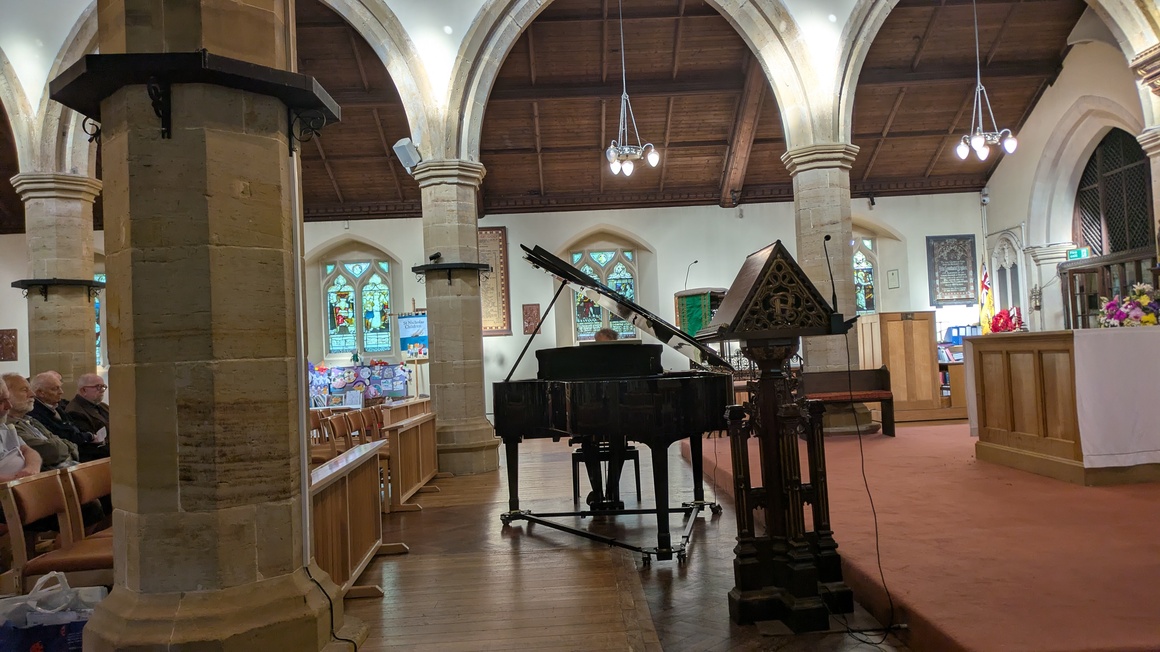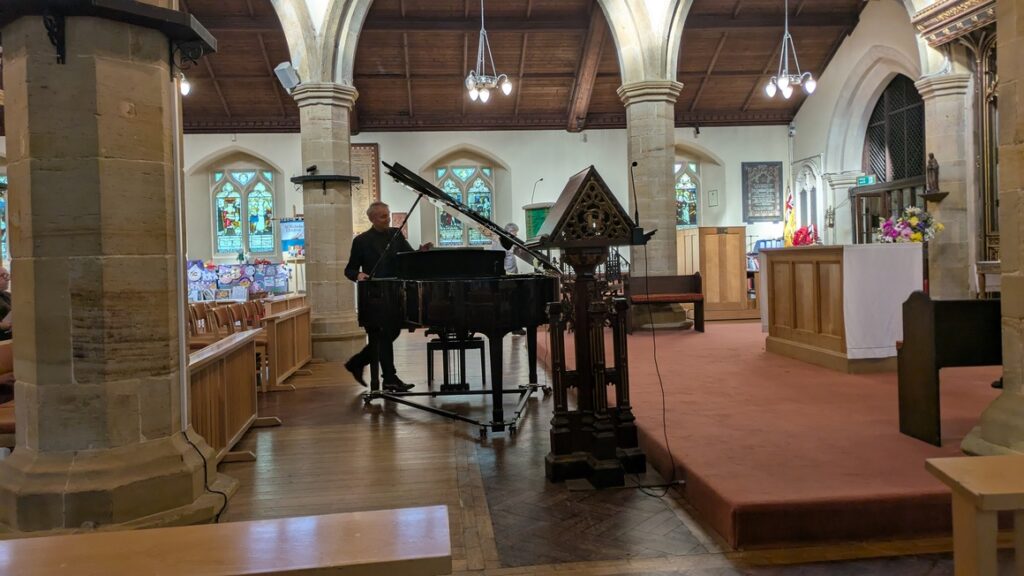Review by Simon Jenner, October 22 2025
★ ★ ★ ★ ★
James Kirby’s piano recital at St Nicholas Church, Brighton underscores how this is becoming a go-to for some of the most prestigious artists on the circuit: indeed many circuits.
This is a special and surprisingly rare recital of Schumann and Liszt standards. James Kirby who made the semi-finals of the Tchaikovsky Piano Competition no less, isn’t a household name as soloist because he’s feted abroad, and began with much travelling to the Soviet Union in the wake of that competition placement. Particularly he concertises in the far east. But when he has been in the UK he’s also been known as part of the Barbican Trio for over 30 years, and working with the great violinist Lydia Mordkovich. His British concertizing with orchestras though is widespread, as well as his conservatoire teaching.
Kirby’s also an engaging presenter of the works he plays, presenting each as he goes.
Kirby starts with the lilting Schumann Arabesque in C Op 18 from 1839. It insinuates itself almost as a pale and exquisite dance before the thundering main item. Kirby clearly relishes the contrasts, its sashay of tonal shadows and C major brightness, as the title suggests. It’s a brief work, like an extended prelude.
Liszt’s 1855 Fantasia and Fugue on BACH is a gauntlet fling down to those who thought Liszt somehow superficial. With tone poems emerging and the Piano Sonata two years behind him, one is reminded Liszt composed for the organ. Indeed this piece started as an organ work, immediately transcribed for the piano. And the key cipher of Bach’s name (BAC B natural, or H in German notation), underscored something Bach himself began to experiment with: the letters of his own name turned into music. It’s had a huge effect since Liszt began the trend: notably with Shostakovich and Ronald Stevenson (in homage to Shostakovich). The actual form – revived by Liszt – influenced composers from César Frank onwards, through Max Reger and French, German, British and Belgian composers for organ and piano.
The opening Fantasia hails from that thunderous abode of the organ loft, building layers and releasing them in terraced waves, something Kirby is particularly successful in conveying, where textures could easily get muddy. It can prove an overwhelming tonal experience which the fire-stepped Fugue renders even more intense. Both gothic and modern for Liszt’s time, it’s a work that repays absorption and spaces between.
Something of that intensity informs Schumann ‘s Faschingsschwank aus Wein or Carnival Jest From Vienna, which seems to date from the late 1830s. It’s a kind of kaleidoscope of the carnival where players shadows and lovers peep out. And someone wants to throw a bomb. Or a tricolour. Containing some of Schumann finest music for the piano it’s also an elusive piece with a singular structure for the time.
The first movement Allegro (Sehr Lebhaft) in B flat might playfully end by quoting the banned Marseillaise. But it’s heterogenous, even for these five pieces: there’s a moment of intensity and build that releases an explosion – something Richter managed beautifully. Kirby too gives it the right intensity, the most incandescent moment in all Schumann with its stabbing repeated notes a cry of agony. Described as how the “piece comes to a crashing close with almost dissonant septuplet arpeggios” it nears terror. Yet it’s never revisited, unless more soberly in the fourth movement.
It’s the most substantial movement. The gentle G minor Romanza (Zeimlich Langsam/fairly slow) despite the intense key, is more Biedermeier (a domestic retreat into sentimentality after all the bomb-throwing) to the first movement’s revolutionary ardour. A reverie of love it’s poised, memorable and soon over in radiant G major. Even more catchy is a return to the B flat major in the Scherzino: a kind of waltz scherzo with a lilt. It’s both light and more than a ghost of Puck inhabits it.
The Intermezzo (Mit Grosser Energie/with great energy) again in is vintage Schumann recalling his C major Fantasie Op 17. It’s in a shadowy E flat minor, a remote and potent key; the only piano piece of the romantic era that comes to mind is Brahms’ late Intermezzo Op 118/6 from 1892, apparently a sketch for an unwritten fifth symphony. Its rolling paragraphs and passionate assertions are proof of Schumann ‘s Eusebius mode – those two imagined halves that rode him: the extrovert and introvert (possibly imagined from his sign of Gemini, the Twins).
The extrovert Florestan is back in the B flat Finale (Hochst Lebhaft/extremely lively) which is both exuberant and not as simply boisterous as Florestan can be. There’s optimism and joy as if Schumann himself is sending coded messages to Clara Wieck whom he was to marry despite her father. This mood finally e in ns out but there some exciting and minor keyed development. Triumph over some adversity.
The final piece returns to Liszt though here as transcriber. Liszt transcribed the world in service to all the great and many not as great as him: his vast catalogue of reductions include opera paragraphs and all Beethoven symphonies for domestic playing. If you could play like Liszt or Clara Schumann as she became. Kirby clearly loves the wildest moments of Schumann to match Liszt’s.
Certainly Wagner couldn’t play the piano. He and Berlioz are the first composers who couldn’t really play a thing. A curious by-product of romanticism. Wagner’s Prelude and Liebestod from his 1859 opera Tristan and Isolde introduce the twelve notes in the harmonic scale, something learned from Liszt’s Faust Symphony.
What Liszt does is splice the opening and finale or consummation at death moments from each end of the opera. In a way too he’s reclaiming some of that harmonic daring learned from him by Wagner. Though thrilling orchestrally Liszt makes it an equal experience confined to the glittering twinge if his pianist.
Kirby relishes the Prelude with its harmonic daring and the climactic Liebestod moment which is in effect an orgasmic death of Isolde’s. Here the climax and nailing progressions hammered out with clarity and affect are utterly transporting: ideally clear – every note a taste of its own separation – and yet rapturous. A stunning discovery.
Photo Credit Simon Jenner




